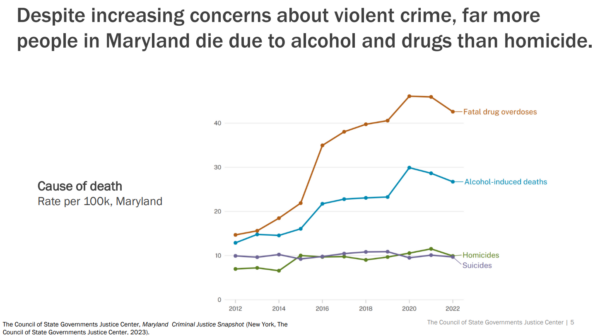The Senate Judicial Proceedings Committee held its final criminal justice reform briefing Tuesday to assess data and trends of violent crimes not only in Maryland, but nationwide.
According to a more than one-hour presentation by the Council of State Governments’ Justice Center, violent crime in Maryland decreased by 16% between 2012 and 2022, compared to the national average decrease of 2%.
During that 10-year span, aggravated assault decreased by 11% and robbery by 34%. Nationally aggravated assault increased by 10% and robbery decreased by 42%, on average.
According to the Justice Center, rape in Maryland increased by 46% and homicides by 35%. The national average increase in rape was 47% and the national average increase in homicide was 34%.
“The public is concerned about crime and distrusts the justice system’s ability to be able to handle what is a perceived rise in violence,” said Madeleine Dardeau, project manager for the Justice Center, which is based in New York.
That’s because, in some states including Maryland, some kinds of violent crime did increase.
Dardeau said more people died in Maryland from alcohol and drugs than from homicides between 2012 and 2022.

The figures the committee reviewed strictly focused on adult crime, but much of the conversation in Maryland has been on juvenile justice.
According to a report from the state Department of Juvenile Services released in September, non-fatal shootings for youth ages 18 and younger rose from 41 in 2013 to 171 in 2022 on a fairly steady rise. During that time, homicides increased from 29 in 2013 to 47 in 2022.
Some law enforcement officials and state’s attorneys have said laws passed by the legislature in 2022, such as Juvenile Justice Reform, could use a few tweaks.
Nina Salomon, deputy division director for corrections and reentry for the council’s Justice Center, disagrees.
“That law that was signed really mirrors what a lot of states have been doing the last several years in terms of reforming their juvenile justice system, and that’s really focusing on the low-risk kids and getting those kids out of the juvenile justice system,” she said.
Salomon said the national average of youth in the juvenile justice system who committed violent offenses is between 7% to 8%.
“It’s really important to not be reactionary, but really take a step back and respond with data-driven, research-based solutions,” Salomon said.
She said that an executive order which Gov. Wes Moore (D) signed Thursday to create the Governor’s Office for Children would help increase services for youth.
State comparisons
As for ways to decrease crime in Maryland, the Justice Center pointed to two states that chose to invest in augmenting resources for police departments.
Arkansas passed a law last year to create a $1 million Violent Crime Clearance Grant Fund for law enforcement agencies to solve violent crime.
According to the legislation, some of the money may be used for training, equipment and information systems for criminal justice purposes. In addition, money can provide services for victims of violent crimes.
New York Gov. Kathy Hochul (D) announced an initiative last year for police departments and district attorneys in five cities to share $866,564 to investigate and solve non-fatal shooting cases. The resources are viewed, according to the governor’s office, to prevent retaliation and reduce gun violence.
The city of Denver provided similar resources for its police department in 2020 to solve non-fatal shootings similar to homicides.
Dardeau said that, in these examples, resources are more focused on specialized services that not only hold people accountable, but can decrease overall crime.
Back in Maryland, Moore released a spending plan last week that proposes $127 million to local law enforcement and $10 million to create the new Center for Firearm Violence Prevention and Intervention within the state Department of Health.
The governor also allocated an additional $16 million for the Department of Juvenile Services, which houses and monitors some of the state’s troubled youth.
The Justice Center presented several recommendations that Dardeau said could reduce crime in Maryland and other states, including addressing trauma to prevent trauma, committing to a statewide recidivism-reduction goal and investing in data-driven violence prevention.
Sen. Charles Sydnor III (D-Baltimore County) asked if the Justice Center assessed whether other states have decreased the responsibilities of police officers. For example, he said additional resources should be used to deploy behavior or health care specialists to assist someone homeless versus calling the police.
“Police officers should hold people accountable who are killing people and raping people. That’s what I want,” he said.
Sen. William C. Smith Jr. (D-Montgomery), chair of the committee, said Tuesday’s presentation will help the committee assess proposed legislation during the legislative session.
The information “will help us make educated, sound-wise decisions as we move through the session,” he said.



